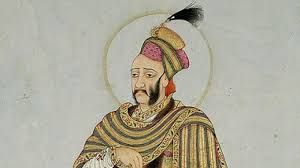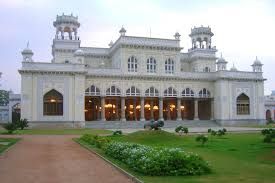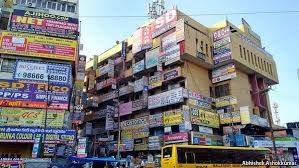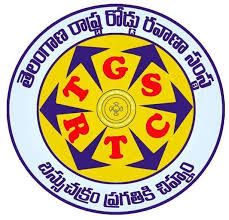The name Hyderabad combines Persian roots with a nod to historical significance. Hyder refers to Hyder Ali, a prominent 18th-century ruler renowned for his leadership and military skills. The term "abad" means city or settlement in Persian. Together, Hyderabad translates to City of Hyder, Hyderabad's rich heritage is showcased through landmarks like the Charminar and Golconda Fort, while its economic significance is highlighted by its status as a hub for the IT and biotechnology industries. The city's diverse cultural scene includes a range of festivals, culinary delights like Hyderabadi biryani, and a blend of traditional and contemporary influences, making it a dynamic and culturally rich metropolis.
History of Hyderabad
| Hyderabad was established in 1591 by Muhammad Quli Qutb Shah, the fifth ruler of the Qutb Shahi dynasty. The city was initially built to serve as a new capital for the Qutb Shahis, who had been ruling from Golconda Fort. Muhammad Quli Qutb Shah chose the site on the banks of the Musi River due to its strategic location, which was advantageous for trade and defence. The city's layout was meticulously planned, with wide streets and a grid-like pattern, and it quickly grew into a bustling centre for trade and culture. |
|
Key Historical Events and Periods
Qutb Shahi Dynasty (1591-1687): The Qutb Shahis were known for their contributions to architecture and culture. During their rule, Hyderabad saw the construction of iconic structures such as the Charminar and Mecca Masjid, as well as flourishing arts and literature. The dynasty ended when the city was conquered by the Mughal Emperor Aurangzeb in 1687.
Mughal Era (1687-1724): Under Mughal control, Hyderabad was integrated into the vast Mughal Empire. While the city continued to prosper, the Mughal administration was often distant, allowing local rulers considerable autonomy.
Nizam Rule (1724-1948): In 1724, the Mughal Emperor appointed Mir Qumruddin, later known as Nizam-ul-Mulk Asaf Jah I, as the governor of the Deccan region. He established the Nizam dynasty, which ruled Hyderabad State with a high degree of autonomy. The Nizams were known for their efforts to modernize the city, introducing advancements in infrastructure, education, and healthcare.
Post-Independence Era (1948-Present): Hyderabad was annexed into the Indian Union in 1948 following Operation Polo. The city has since evolved into a significant economic and technological hub. In 2014, it became the capital of the newly formed state of Telangana, reflecting its continued importance in regional and national affairs.
Landmarks and Monuments (Tourism and Attractions in Hyderabad)
Charminar
The Charminar, built in 1591 by Muhammad Quli Qutb Shah, is one of Hyderabad’s most iconic landmarks. It was constructed to mark the city's founding and celebrate the end of a plague. The structure features a square base with four grand arches and four towering minarets, each 24 meters high. Its design merges Persian and Indian architectural styles, highlighted by intricate carvings and a large central dome
Golconda Fort
Golconda Fort, originally a mud fort built in the 13th century and later expanded in the 16th century by the Qutb Shahi rulers, was a crucial center for the diamond trade. The fort’s impressive 7-kilometre-long outer wall and notable gateways, such as the Fateh Darwaza (Victory Gate), are renowned for their defensive design. The fort also features an advanced acoustic system, allowing sounds made at the base to be heard clearly at the top.
Qutb Shahi Tombs
The Qutb Shahi Tombs, built between the 16th and 17th centuries, serve as the final resting places for the rulers of the Qutb Shahi dynasty. Located near Golconda Fort, these tombs are distinguished by their large domes, detailed carvings, and spacious courtyards. The architectural style is a blend of Persian, Indian, and Central Asian influences, reflecting the grandeur of the Qutb Shahi era.
Chowmohalla Palace
|
|
Chowmohalla Palace, constructed in the 18th century by Nizam Mahbub Ali Pasha, was the official residence of the Nizams of Hyderabad and a hub for royal events. The palace combines Venetian, Tudor, and Mughal architectural styles, with notable features including the grand Khilwat Mubarak (main audience hall), which boasts elaborate chandeliers and opulent decor. The palace is now a heritage site offering a glimpse into the luxurious lifestyle of the Nizams. |
Hussain Sagar Lake
Hussain Sagar Lake, created in 1562 by Ibrahim Qutb Shah, was designed to meet the city’s water needs. The lake is famous for the Buddha Statue on an island in the center, which stands 18 meters tall. It is a popular spot for boating and leisurely strolls, and its scenic surroundings make it a key recreational area in Hyderabad.
Salar Jung Museum
Founded in 1951, the Salar Jung Museum houses one of the largest collections of antiques amassed by Mir Yusuf Ali Pasha Salar Jung III. The museum’s diverse collection includes sculptures, manuscripts, and paintings from various cultures. Highlights include the statue of Veiled Rebecca and numerous Persian and Indian artworks, set within an architecturally significant building that blends traditional and modern elements.
Mecca Masjid
Mecca Masjid, built between 1614 and 1694, is one of Hyderabad’s oldest and largest mosques. Constructed during the Qutb Shahi and Mughal periods, the mosque features a grand central dome and four minarets. The mosque’s walls are made from bricks brought from Mecca, which is how it got its name. It remains an important religious site and an example of historical Islamic architecture in Hyderabad.
Falaknuma Palace
Falaknuma Palace, built in 1894 by Nizam Mahbub Ali Pasha, was intended as a guesthouse for visiting dignitaries. The palace is noted for its blend of Venetian, Tudor, and Mughal architectural styles, and it includes a grand ballroom, one of the largest in the world. Now a heritage hotel, it offers visitors a glimpse into the opulent lifestyle of Hyderabad’s Nizams with its luxurious interiors and exquisite design.
Economy and Business
Business Hubs in Hyderabad
Hyderabad stands out as a major business hub in India, driven by several key areas that fuel its dynamic economy. HITEC City, the epicentre of Hyderabad's IT industry, hosts global tech giants like Microsoft and Google, establishing itself as a central business district. Nearby Gachibowli is renowned for its high concentration of IT firms and financial institutions, significantly contributing to the city's commercial growth. Madhapur, adjacent to HITEC City, supports this tech-centric focus with its own array of business centres and a vibrant startup ecosystem.
| Ameerpet, located strategically between HITEC City and the city centre, is a notable business area that adds to Hyderabad's commercial diversity. Known for its educational institutions and training centres, Ameerpet also hosts numerous office spaces and retail establishments, contributing to the city’s dynamic business environment. |
|
Banjara Hills offers an upscale commercial setting, housing high-end offices and financial institutions, while Secunderabad, Hyderabad’s twin city, features a diverse industrial base including manufacturing and logistics. Kondapur, part of the broader IT and business district, is rapidly evolving with a focus on technology and office spaces. Collectively, these hubs reinforce Hyderabad's position as a prominent business and technology centre.
Startups and Innovation
Hyderabad has emerged as a prominent startup hub, especially in sectors like fintech, health tech, and e-commerce. Notable startups such as Zomato, Swiggy, and Razorpay have gained national and international acclaim. Zomato and Swiggy have transformed the food delivery industry, making online ordering more accessible and convenient. Razorpay, on the other hand, has streamlined online payment processes, benefiting both businesses and consumers. The city's thriving startup ecosystem is supported by a favourable environment for new ventures, which has fueled its rapid growth.
Key to the success of startups in Hyderabad are its tech parks and incubators. T-Hub stands out as one of the largest and most influential incubators in India, offering startups essential resources, expert mentorship, and networking opportunities. It provides infrastructure, office space, and connections to investors, playing a critical role in the growth of new companies.
Similarly, I-Hub focuses on technology innovation, supporting startups with funding, resources, and a collaborative environment, while The Hyderabad Angels offers early-stage funding and strategic advice to help startups navigate their initial phases.
Additional support for Hyderabad's startups comes from various organizations and events. Skill development centres provide training and workshops for aspiring entrepreneurs, enhancing their skills and knowledge. Startup Weekend Hyderabad fosters collaboration among entrepreneurs, developers, and business experts, helping participants develop their ideas into viable business models. The Hyderabad Software Enterprises Association (HYSEA) supports IT and software startups with networking opportunities and advocacy, further strengthening the city's position as a leading centre for technology and entrepreneurship.
Major Industries
Information Technology (IT):
The IT sector is one of Hyderabad's biggest economic contributors, with the city housing numerous global tech giants and IT companies. HITEC City, a major IT and business district, is home to major firms like Microsoft, Google, and Facebook. The sector benefits from a skilled workforce, supportive infrastructure, and favorable government policies.
Biotechnology and Pharmaceuticals: Hyderabad is known as "Genome Valley" due to its prominence in biotechnology and pharmaceuticals. The city hosts numerous biotech and pharma companies, including industry leaders such as Dr. Reddy’s Laboratories and Bharat Biotech. The presence of research and development facilities, along with a robust regulatory framework, supports innovation in these fields.
Manufacturing: The manufacturing sector in Hyderabad is growing, particularly in areas like aerospace, defense, and automotive. The city's strategic location and developed infrastructure make it an attractive destination for manufacturing investments. The presence of major players like Tata Advanced Systems and the growth of industrial parks contribute to the sector’s expansion.
Retail and E-Commerce: Retail and e-commerce are vibrant sectors in Hyderabad, driven by a growing consumer base and increasing internet penetration. Major e-commerce companies have established significant operations in the city, and Hyderabad's retail market continues to expand with numerous shopping malls and commercial centres catering to diverse consumer needs.
Education and Research
Institutions
Institutions like the Indian School of Business (ISB) and the University of Hyderabad provide robust academic programs and research opportunities across various disciplines. ISB offers programs such as the Post Graduate Programme in Management (PGP), Executive Education, and the Fellow Programme in Management (FPM), focusing on leadership and global perspectives through international partnerships and cutting-edge research. The University of Hyderabad covers diverse fields including science, social sciences, humanities, and management, with a strong emphasis on research in biotechnology, environmental sciences, and social policy. Osmania University, established in 1918, is one of India’s oldest institutions, offering a wide range of programs in arts, science, commerce, and engineering, and is well-regarded for its contributions to engineering and technology. institutions like SkillFloor enhance career development by providing practical, career-oriented training in digital marketing, data science, and other fields, bridging the gap between academic learning and industry requirements.
Prominent Research Centers
Hyderabad is home to several esteemed research institutions that make significant contributions to their respective fields:
Indian Institute of Chemical Technology (IICT): IICT specializes in chemical sciences, including research in chemical engineering, organic chemistry, and materials science. It plays a key role in developing new chemical processes and technologies.
Centre for Cellular and Molecular Biology (CCMB): CCMB focuses on cellular and molecular biology research. Its work spans genetics, molecular medicine, and biotechnology, contributing to advancements in understanding diseases and developing new treatments.
International Institute of Information Technology (IIIT-H): IIIT-H is renowned for its research in information technology and computer science. It works on cutting-edge topics such as artificial intelligence, data science, and cybersecurity, influencing both academic research and practical applications.
Events and Festivals
Hyderabad is renowned for its vibrant festivals and events that celebrate its rich cultural heritage. Major festivals include the Deccan Festival, held in February, which showcases the city's diverse cultural influences through exhibitions and performances. Sankranti, celebrated in January, features colourful kite flying and traditional foods, while Diwali, the Festival of Lights, is marked by elaborate decorations and fireworks.
Eid al-Fitr and Eid al-Adha are celebrated with communal prayers and feasts, and Ugadi, the Telugu New Year, involves traditional rituals and cultural performances.
The city also hosts key events such as the Hyderabad Literary Festival, which brings together authors and literary enthusiasts for discussions and workshops, and the Hyderabad International Film Festival, which highlights global cinema. Numaish, an annual trade fair held in January, offers a wide range of products and showcases Hyderabad's market culture. Additionally, World Music Day in June celebrates music with performances by both local and international artists, reflecting the city's vibrant arts scene.
Neighbourhoods
Banjara Hills: Characteristics and Amenities Banjara Hills is one of Hyderabad's most upscale neighbourhoods, known for its luxurious residential properties and vibrant commercial spaces. This area is well-equipped with high-end shopping centres, gourmet restaurants, and premium healthcare facilities. The lush greenery and well-maintained parks, such as the popular Necklace Road, add to the charm. It's also a hub for cultural activities, with several art galleries and cultural centres.
Jubilee Hills: Lifestyle and Local Attractions Jubilee Hills offers a blend of affluence and cultural richness. The area is known for its spacious homes, upscale dining, and trendy boutiques. It is also home to several landmarks, including the popular Shilparamam cultural village, which hosts traditional arts and crafts exhibitions. Residents enjoy access to well-established schools, fitness centres, and recreational facilities, making it a sought-after locality for families and professionals alike.
Secunderabad: Historical Significance and Local Life Secunderabad, often referred to as the twin city of Hyderabad, holds significant historical value with its colonial-era architecture and historical landmarks. It is known for its bustling markets and diverse community life. Places like the Secunderabad Club and the parade grounds offer insights into its rich past. The area has a vibrant local life, with numerous traditional eateries, bazaars, and cultural festivals that highlight its heritage and communal spirit.
Local Markets
Laad Bazaar: Known for Bangles and Traditional Goods Laad Bazaar, located near the historic Charminar, is renowned for its colorful bangles and traditional jewellery. This market is a sensory delight, with stalls offering a wide range of vibrant bangles, ethnic wear, and traditional artefacts. It’s a popular destination for both locals and tourists looking for unique, handcrafted goods that reflect Hyderabad's rich cultural tapestry.
Moazzam Jahi Market: Variety and Offerings Moazzam Jahi Market is a bustling spot known for its diverse range of goods, including fresh produce, spices, and textiles. This historic market, housed in a grand building dating back to the early 20th century, provides a taste of local life with its vibrant atmosphere and extensive selection. It’s an ideal place to experience Hyderabad’s traditional market culture and pick up a variety of local products.
Community Activities
Local Clubs and Societies: Activities and Focus Areas Hyderabad boasts a range of local clubs and societies that cater to various interests, from book clubs and sports associations to arts and social service organizations. These clubs offer members opportunities to engage in recreational activities, community service, and social gatherings. They play a significant role in fostering a sense of community and providing platforms for personal growth and networking.
Volunteering and Social Initiatives: Local Impact Volunteering and social initiatives are integral to Hyderabad’s community life, with numerous organizations working on issues such as education, health, and environmental sustainability. These initiatives often include programs aimed at improving local infrastructure, supporting underprivileged communities, and promoting social welfare. Volunteers in Hyderabad actively contribute to these causes, making a tangible impact on local society and fostering a spirit of collaboration and support.
Transportation and Connectivity in Hyderabad
|
|
Hyderabad offers a comprehensive public transport network featuring the Hyderabad Metro, which includes the Red, Blue, and Green Lines connecting key city areas. The metro provides a fast and efficient way to navigate the city. Complementing the metro are extensive bus services managed by the Telangana State Road Transport Corporation (TSRTC), covering major routes to neighbourhoods, commercial centres, and neighbouring towns. |
Auto rickshaws and app-based cabs like Uber and Ola offer flexible options for short trips and longer commutes, with fares varying based on distance and traffic conditions.
In terms of road infrastructure, Hyderabad is well-connected by major highways such as NH65 and NH44, linking the city to Pune, Bangalore, and Delhi. The Outer Ring Road (ORR) is a crucial route that circles the city, alleviating traffic congestion and providing smooth transit. Key roads like Necklace Road enhance connectivity between various city landmarks, although traffic patterns can become congested during peak hours and around busy commercial areas.
For air travel, Rajiv Gandhi International Airport (RGIA) serves as the city's primary gateway, offering modern facilities and direct flights to major domestic and international destinations. The airport connects Hyderabad to important cities across India and key international hubs like Dubai and London, making it a pivotal node for both business and leisure travel.
Famous foods and food streets
Related Posts
Top Places to Visit in Hyderabad in 3 Days
Explore must-visit places in Hyderabad in just 3 days, including historical site...
IT Companies In Hyderabad For Freshers
Explore top IT companies in Hyderabad hiring freshers. Discover opportunities, c...
Top colleges in Hyderabad for MBA
The top MBA colleges in Hyderabad, including rankings and admissions details. Fi...
Related Posts
Top Places to Visit in Hyderabad in 3 Days
Explore must-visit places in Hyderabad in just 3 days, including historical site...
IT Companies In Hyderabad For Freshers
Explore top IT companies in Hyderabad hiring freshers. Discover opportunities, c...
Top colleges in Hyderabad for MBA
The top MBA colleges in Hyderabad, including rankings and admissions details. Fi...
























































